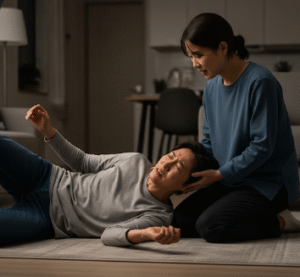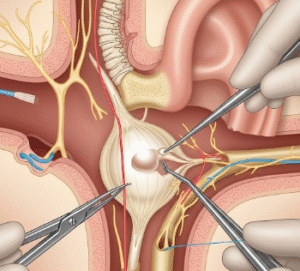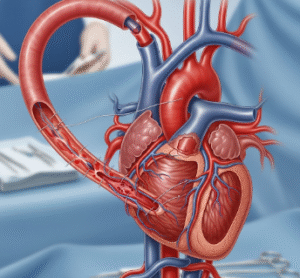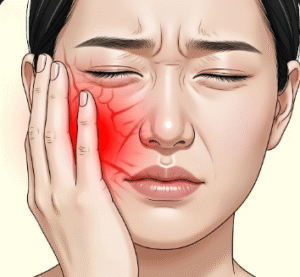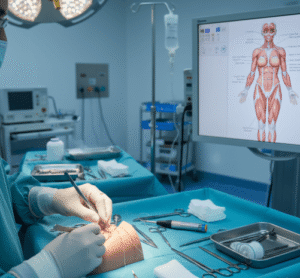Overview
Numbness, also called paresthesia, refers to a loss of sensation or a tingling feeling in a part of the body. It can affect the skin, limbs, or even the face and may be temporary or chronic depending on the underlying cause. Numbness is often a symptom rather than a disease, signaling nerve compression, circulation problems, or neurological disorders.
In Korea, medical evaluation for numbness involves a combination of neurological assessment, imaging, and lab tests to determine the underlying cause and prevent long-term complications.
Key Facts
➤ Numbness can be localized or widespread, affecting one limb, both limbs, or parts of the face.
➤ It may be associated with tingling, burning, or a pins-and-needles sensation.
➤ Causes range from temporary compression of nerves to serious conditions like stroke or diabetes.
➤ In Korea, early detection and treatment help prevent nerve damage and functional impairment.
➤ Numbness may be intermittent or persistent, depending on the condition.
What is Numbness?
Numbness occurs when nerve signals between the brain, spinal cord, and affected area are disrupted. This can be due to pressure, injury, inflammation, or systemic conditions.
➔ Types of numbness:
- Peripheral numbness – affects arms, legs, hands, or feet.
- Cranial numbness – affects face, lips, or tongue.
- Segmental or patchy numbness – occurs in certain skin areas, often in dermatome patterns.
The sensation can feel like loss of touch, reduced sensitivity, or tingling, sometimes accompanied by pain or weakness.
Symptoms Related to Numbness
➤ Tingling or “pins-and-needles” sensation.
➤ Loss of feeling or reduced sensitivity in the affected area.
➤ Burning, prickling, or stabbing sensations.
➤ Weakness or clumsiness in limbs.
➤ Difficulty grasping objects or walking if hands or feet are involved.
➤ Sometimes associated with pain or stiffness in surrounding muscles or joints.
Causes / Possible Causes
Numbness can result from various neurological, vascular, or systemic factors:
Neurological Causes
➤ Peripheral neuropathy – often due to diabetes or vitamin deficiencies.
➤ Nerve compression – herniated discs, carpal tunnel syndrome, or spinal stenosis.
➤ Stroke or transient ischemic attack (TIA) – sudden numbness on one side of the body.
➤ Multiple sclerosis – autoimmune demyelinating disease.
Vascular Causes
➤ Poor circulation – atherosclerosis or peripheral artery disease.
➤ Blood clots or thrombosis – reducing blood flow to limbs.
Metabolic and Other Causes
➤ Diabetes mellitus – chronic high blood sugar causing nerve damage.
➤ Vitamin B12 deficiency – leading to nerve degeneration.
➤ Medication side effects – chemotherapy, certain antibiotics, or anticonvulsants.
➤ Infections or autoimmune conditions – like Lyme disease or lupus.
Temporary Causes
➤ Pressure on a nerve from sitting, sleeping, or repetitive movement.
➤ Exposure to cold temperatures causing reduced blood flow.
Risk Factors
➤ Diabetes or prediabetes.
➤ Older age, which increases risk of nerve degeneration.
➤ History of stroke, spinal injury, or nerve compression disorders.
➤ Poor nutrition or vitamin deficiencies.
➤ Prolonged pressure on a limb or repetitive movements.
➤ Smoking, sedentary lifestyle, or circulatory disorders.
Complications
If numbness is chronic or untreated, it may lead to:
➤ Permanent nerve damage affecting sensation and function.
➤ Balance and coordination issues, increasing risk of falls.
➤ Muscle weakness or atrophy from disuse.
➤ Chronic pain or neuropathy, interfering with daily life.
➤ Secondary injuries due to loss of sensation (burns, cuts, or frostbite).
When Should I See My Doctor?
Seek medical attention if:
➤ Numbness is sudden, severe, or affects one side of the body, which could indicate stroke.
➤ It is persistent, worsening, or spreading.
➤ Accompanied by weakness, dizziness, speech difficulty, or vision changes.
➤ You have underlying conditions like diabetes or vascular disease.
➤ There is pain, swelling, or color change in the affected limb.
➤ Numbness interferes with daily activities, walking, or hand function.
Care and Treatment
Lifestyle and Home Measures
➤ Avoid prolonged pressure on limbs; change positions frequently.
➤ Gentle stretching and mobility exercises to improve circulation.
➤ Maintain balanced nutrition, including vitamins B12 and D.
➤ Control blood sugar if diabetic.
➤ Avoid exposure to cold or restrictive clothing.
Medical Treatments
➤ Medications – pain relievers, anticonvulsants, or neuropathic agents.
➤ Physical therapy – exercises to strengthen muscles and restore function.
➤ Surgical intervention – if caused by nerve compression (e.g., herniated disc, carpal tunnel release).
➤ Treatment of underlying disease – diabetes, vitamin deficiency, autoimmune disorders.
➤ Assistive devices for balance or mobility if needed.
Preventive Measures
➤ Regular check-ups for chronic conditions.
➤ Early diagnosis of nerve-related or vascular disorders.
➤ Proper ergonomics and posture during work and daily activities.
➤ Maintain healthy lifestyle habits, including exercise and balanced diet.
Treatment Options in Korea
Korean healthcare provides comprehensive evaluation and management for numbness, including:
Diagnostic Services
➤ Neurological examination and nerve conduction studies.
➤ Imaging – MRI, CT, or ultrasound to detect nerve or spinal issues.
➤ Blood tests for diabetes, vitamin deficiencies, or autoimmune markers.
➤ Vascular assessment for circulatory disorders.
Therapies and Supportive Care
➤ Prescription medications for neuropathic pain or inflammation.
➤ Physiotherapy and rehabilitation programs for functional recovery.
➤ Minimally invasive procedures or surgery for nerve compression.
➤ Multidisciplinary care involving neurology, orthopedics, and rehabilitation specialists.
➤ Education on self-care, preventive strategies, and lifestyle modifications.
✅ In summary: Numbness is a symptom indicating nerve, vascular, or metabolic issues. While temporary episodes may be harmless, persistent or severe numbness requires prompt medical evaluation. In Korea, integrated care ensures accurate diagnosis, targeted treatment, and preventive measures, helping patients restore sensation, prevent complications, and maintain quality of life.



